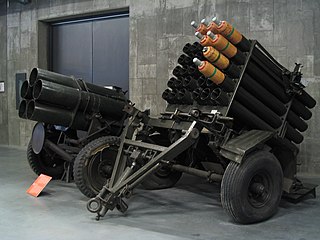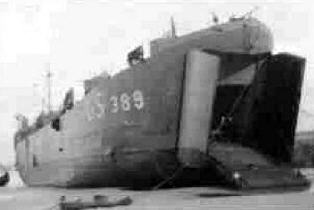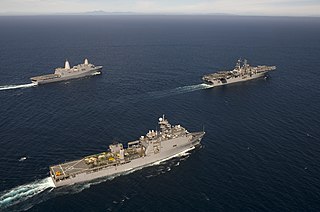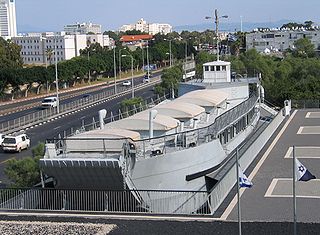
The Space Shuttle is a retired, partially reusable low Earth orbital spacecraft system operated from 1981 to 2011 by the U.S. National Aeronautics and Space Administration (NASA) as part of the Space Shuttle program. Its official program name was Space Transportation System (STS), taken from the 1969 plan led by U.S. Vice President Spiro Agnew for a system of reusable spacecraft where it was the only item funded for development.

Landing craft are small and medium seagoing watercraft, such as boats and barges, used to convey a landing force from the sea to the shore during an amphibious assault. The term excludes landing ships, which are larger. Production of landing craft peaked during World War II, with a significant number of different designs produced in large quantities by the United Kingdom and United States.

The Landing Craft, Tank (LCT) was an amphibious assault craft for landing tanks on beachheads. They were initially developed by the Royal Navy and later by the United States Navy during World War II in a series of versions. Initially known as the "tank landing craft" (TLC) by the British, they later adopted the U.S. nomenclature "landing craft, tank" (LCT). The United States continued to build LCTs post-war, and used them under different designations in the Korean and Vietnam Wars.

A Landing Ship, Tank (LST) is a ship first developed during World War II (1939–1945) to support amphibious operations by carrying tanks, vehicles, cargo, and landing troops directly onto a low-slope beach with no docks or piers. The shallow draft and bow doors and ramps enabled amphibious assaults on almost any beach.

The D-Day Story is a visitor attraction located in Southsea, Portsmouth in Hampshire, England. It tells the story of Operation Overlord during the Normandy D-Day landings. Originally opened as the D-Day Museum in 1984 by Queen Elizabeth The Queen Mother, it reopened as the D-Day Story, following a refurbishment funded by a £5 million Heritage Lottery grant, in March 2018. The museum building was designed by the then city architect Ken Norrish.

DD or duplex drive tanks, nicknamed "Donald Duck tanks", were a type of amphibious swimming tank developed by the British during the Second World War. The phrase is mostly used for the Duplex Drive variant of the M4 Sherman medium tank, that was used by the Western Allies during and after the Normandy Landings in June 1944.

A Landing Craft Utility (LCU) is a type of boat used by amphibious forces to transport equipment and troops to the shore. They are capable of transporting tracked or wheeled vehicles and troops from amphibious assault ships to beachheads or piers.

The RP-3 was a British air-to-ground rocket projectile introduced during the Second World War. The "3 inch" designation referred to the nominal diameter of the rocket motor tube. The use of a 60 lb (27 kg) warhead gave rise to the alternative name of the "60-pound rocket". Though an air-to-ground weapon, it saw limited use in other roles. They were generally used by British fighter-bomber aircraft against targets such as tanks, trains, motor transport and buildings, as well as by Coastal Command and Royal Navy aircraft against U-boats and ships.

Landing Craft Assault (LCA) was a landing craft used extensively in World War II. Its primary purpose was to ferry troops from transport ships to attack enemy-held shores. The craft derived from a prototype designed by John I. Thornycroft Ltd. of Woolston, Hampshire, UK. During the war it was manufactured throughout the United Kingdom in places as various as small boatyards and furniture manufacturers.

The Landing Craft Infantry (LCI) were several classes of landing craft used by the Allies to land large numbers of infantry directly onto beaches during World War II. They were developed in response to a British request for seagoing amphibious assault ships capable of carrying and landing substantially more troops than their smaller assault landing craft (LCA). The result was a small steel ship that could land 200 men, traveling from rear bases on its own bottom at a speed of up to 15 knots.

Mattress was the term applied to ground-based British-devised multiple rocket launchers during World War II. Compared with the German and Soviet counterparts, the western Allies deployed these weapons late in the war. Nevertheless, they did see useful service as artillery support during the crossings of the Rhine and the Scheldt rivers.

USS LST-494 was a United States Navy amphibious tank landing ship that saw combat during World War II in both the European and Pacific Theaters of War. LST stands for Landing Ship, Tank.

USS Benzie County (LST-266) was an LST-1-class tank landing ship built for the United States Navy during World War II. Named for Benzie County, Michigan, she was the only U.S. Naval vessel to bear the name.

USS Boone County (LST-389) was an LST-1-class tank landing ship built for the United States Navy during World War II. Named for counties in Arkansas, Illinois, Indiana, Iowa, Kentucky, Missouri, Nebraska, and West Virginia, she was the only U.S. Naval vessel to bear the name.

The Mark 8 Landing Craft Tank were landing craft tank ships operated by the British Armed Forces. The vessels were based on an American design, but improved into ocean-going vessels capable of sailing to and operating in the Far East.

An amphibious warfare ship is an amphibious vehicle warship employed to land and support ground forces, such as marines, on enemy territory during an amphibious assault.

The Landing Barge, Kitchen or LBK was a landing craft used to support amphibious landings in North Western Europe during and after the Normandy invasion in the Second World War. Its primary purpose was to provide hot meals to the crews of the many minor landing craft not fitted with galley facilities. Constructed of steel, this shallow-draft lighter had storage and serving space to feed 900 men for one week. The kitchen capacity was able to provide 1,600 hot meals and 800 cold meals a day.

Landing Craft, Gun (LCG) is an umbrella term referring to two major types of British-built landing craft used extensively in World War II, present for the Normandy landings, the Allied invasion of Sicily, Operation Infatuate, and more. Their primary purpose was to provide direct fire against beach positions and surface attack for first-echelon landing waves. Secondary roles included engaging light surface vessels and escorting other landing craft.

LCT 147 is an amphibious assault ship for landing tanks, other vehicles and troops on beachheads. Built in 1941 by Stockton Construction, Thornaby-on-Tees, the Mark 2 LCT 147 took part in the Invasion of North Africa in June 1943. The ship was converted to a Landing Craft Rocket at Portsmouth Dockyard from March through May 1943 and renamed LCT(2)(R) 147.

During World War II, the Allies faced an unprecedented challenge with numerous landing operations required both in the Pacific and Europe. This necessitated the design and construction of various landing, supply, and support craft. According to incomplete and imprecise data, thousands of landing craft were built for these operations during the war. The most numerous were assault vehicles and Infantry Landing Craft.






















